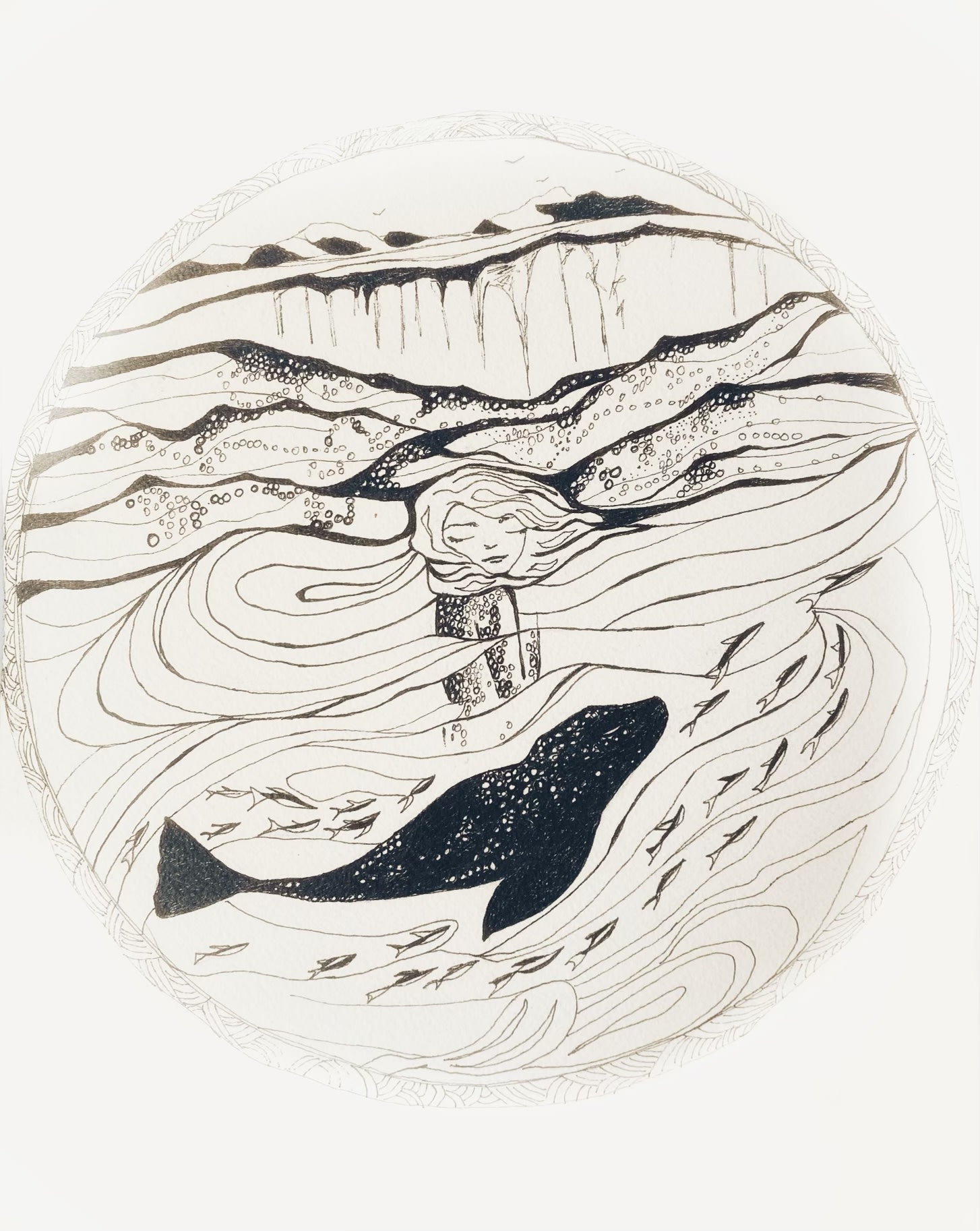The Outrun: A Memoir by Amy Liptrot
304 pages, W.W. Norton & Company, 2017
Book review by Ali Kominsky
Drawing by Courtney W. Brothers
“There is one consolation in being sick; and that is the possibility that you may recover to a better state than you were ever in before.”
—Henry David Thoreau
E nergy never expires. It is carried through water and land and passed on through generations. The energy of water is carried by waves across the ocean; when a wave encounters shallow water its height changes and its energy is transferred to the land. This is known as the shoaling process.
Amy Liptrot’s alcohol addiction drove her into the cliffs, causing lasting physical damage. Her nervous system crumbled. But energy is renewable, and after years of crashing on the rocks, she found a way to direct her force. She uncovered a tonic that would sustain her: the natural world.
Winner of the PEN Ackerley prize for memoir and the 2016 Wainwright prize for best nature, travel, and outdoor writing in Britain, Amy Liptrot recounts a powerful story of recovery in her ecological memoir, The Outrun. Exploring her native Orkney and the Scottish Isles, Liptrot emerges from a long struggle with alcoholism to discover healing in the rich landscape of her homeland.
“Liptrot joins women and men whose writings have turned our attention to the environment—emphasizing its wisdom, and reminding us of our responsibility to protect what is valuable and irreplaceable.”
Nature’s restorative power has long occupied the attention of writers across the world, whose works have established an enduring literary tradition. From Biblical narratives of wilderness to the seventeenth century master of haiku, Bashō—from the German and English Romantics to the American Transcendentalists, from Mary Oliver to Cheryl Strayed—the tradition of seeking meaning in the natural world is an undying staple in literature. Liptrot joins women and men whose writings have turned our attention to the environment—emphasizing its wisdom, and reminding us of our responsibility to protect what is valuable and irreplaceable. Her humorous and insightful prose immediately immersed me, revealing what magic may be found when we choose to open our senses to the world beyond ourselves.
“Recovery is making use of something once thought worthless,” the author writes. “I might have been washed up but I can be renewed.” In The Outrun, recovery translates into healing in the midst of destructive behavioral patterns. Liptrot’s relationship with alcohol was destroying her life: unable to keep a job or maintain precious relationships, she drank to the point of life-threatening tremors. She had tried, with little success, to stay sober in the past. But finally she reached a turning point—multiple court appearances and a violent attack on her life pushed her to enter a rehab program. “I was faced with the reality of doing it for myself,” Liptrot confesses, “which is really the only way.” Choosing herself meant retreating from the world that was familiar to her but could no longer serve her.

The memoir is structured in staccato chapters retelling the author’s journey to find internal healing. Instead of conventional chronology, her narrative weaves scenes from her former experiences of addiction in London, meditations on her childhood, and descriptions of her contemporary environment in Orkney—a series of disjointed vignettes reflecting the complexity of her psychological landscape.
Replacing the thrill of intoxication with the potency of the sublime, Liptrot transforms herself through an intense process of purification (indeed, “sublimation” denotes the purification of substances in chemistry, or transmutation to a higher state of spiritual existence). Her descriptions of the ecosystem around her reveal an insatiably curious individual making meaning out of mundane materials. She introduces us to ambergris—a rare, valuable substance used in perfumery which originates in the stomachs of sperm whales. Through her distinctive lens we learn about lambing season, the history of global trade routes, corncrakes, selkies, and constellations.
“Replacing the thrill of intoxication with the potency of the sublime, Liptrot transforms herself through an intense process of purification.”
Liptrot’s intertwining of ecological processes with local lore locates magic in everyday life. In contrast to the illusions and distortions that characterized her long season of inebriety, she tells us of naturally occurring wonders such as the Fata Morgana, which suggests the kind of sober experience that helps soothe her recovery. Almost an ephemeral hallucination, the superior mirage is a phenomenon of light bending as it passes through layers of air at different temperatures. “A Fata Morgana can be seen yet never approached,” Liptrot explains. “It always remains on the strip of the horizon.” Echoing Kant, who characterized the sublime as being uninhibited by limitations, the author’s encounters with the sublime in nature usher her toward a deeper understanding of her potential, replacing the faux sublimity she once sought in the depths of a bottle.
Amy Liptrot’s first day of sobriety fell on the Spring Equinox. Each solstice and equinox since then has marked another quarter year of sobriety. On one particular summer solstice she ran naked circles around a neolithic structure that she’d previously noticed after looking for corncrake. That night, the pile of stones had interrupted her fantasies of spotting the enigmatic bird. Returning on the longest day of the year, she celebrated the cycles that dependably governed the earth, relishing the meteorological pivot that commemorated her own. The witching hour found her far from any nightclub—orbiting rocks much older than addiction, enraptured in the dry core of her being.
Today, scrolling through Liptrot’s Instagram, I’m perusing pictures of her adventures in nature. I’m comforted to see snapshots of her beautiful family, daily swims in an icy sea, and the seals at Papay, where she found solace time and again.
Her most recent post features old photos from late nights driving around Orkney, listening for the elusive corncrake. Her caption confirms that these weeks around midsummer still feel full of possibility for her. She’s still looking for night-shining clouds, keeping her ears out.